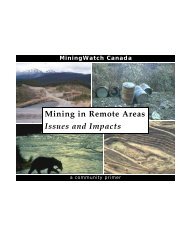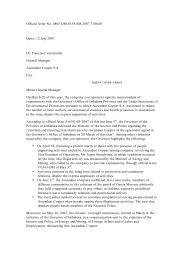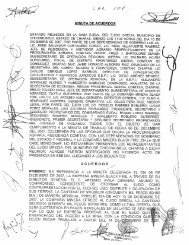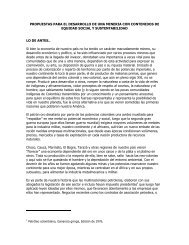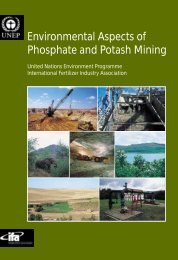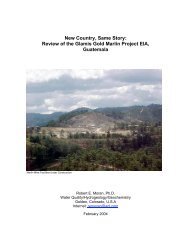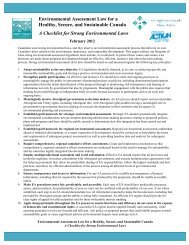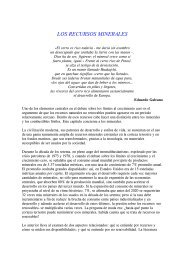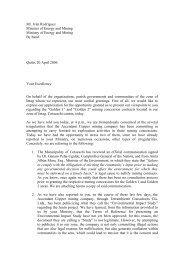Living Near A CHROMITE MINE - MiningWatch Canada
Living Near A CHROMITE MINE - MiningWatch Canada
Living Near A CHROMITE MINE - MiningWatch Canada
You also want an ePaper? Increase the reach of your titles
YUMPU automatically turns print PDFs into web optimized ePapers that Google loves.
<strong>Living</strong> near a<br />
<strong>CHROMITE</strong><br />
<strong>MINE</strong><br />
OR FERROCHROME<br />
FACILITY:<br />
things you should know 1<br />
<strong>MiningWatch</strong><br />
<strong>Canada</strong><br />
Chromite Series<br />
Fact Sheet # 03<br />
Introduction<br />
Chromite is a mineral that contains the<br />
element chromium. The major use for<br />
mined chromite is the production of ferrochrome,<br />
an iron-chromium alloy used to<br />
make stainless steel.<br />
Recently, chromite deposits have been<br />
identified in Northern Ontario, <strong>Canada</strong>.<br />
Located 500 km north-east of Thunder<br />
Bay in a pristine area dubbed the “Ring of<br />
Fire”, they are the largest deposits found<br />
in North America. Cliffs Natural Resources<br />
is evaluating a plan for an open pit/underground<br />
chromite mine and ore processing<br />
facility in the Ring of Fire and a ferrochrome<br />
production facility to be located<br />
somewhere in Ontario. A number of other<br />
companies also have plans for mining<br />
chromite and other metals in the area.<br />
This fact sheet is part of a series produced<br />
by <strong>MiningWatch</strong> <strong>Canada</strong> about the risks<br />
of chromium mining and processing. Additional<br />
fact sheets and a more extensive<br />
review of relevant scientific research entitled<br />
Overview of Chromium, Chromite and<br />
Toxicity, are also available on our website.<br />
References for the information presented<br />
in this fact sheet can be found in the full<br />
review.<br />
Is chromium dangerous?<br />
The two most common types of chromium<br />
are trivalent chromium (Cr-III), which<br />
is found in the mineral chromite, and<br />
hexavalent chromium (Cr-VI). While Cr-III<br />
is considered an essential trace element in<br />
human diets, high doses can cause health<br />
problems and harm sensitive plants and<br />
animals. Human activities such as chromite<br />
mining and ferrochrome processing<br />
can convert Cr-III into Cr-VI, which is 100-<br />
1000 times more toxic than Cr-III and is<br />
known to cause cancer.<br />
1 Information taken from: An Overview of Chromium, Chromite and Toxicity by <strong>MiningWatch</strong> <strong>Canada</strong>, 2012.
“The existence and treatment<br />
of wastes from<br />
stainless steel and ferrochrome<br />
production remain<br />
a challenge and an issue of<br />
concern”<br />
Ma and Garbers-Craig 2006<br />
Units of Measurement:<br />
1 million micrograms (ug)<br />
equals 1 gram (g).<br />
1 thousand milligrams (mg)<br />
equals 1 gram.<br />
1 thousand grams equals 1<br />
kilogram (kg).<br />
For every tonne of ferrochrome<br />
created, up to<br />
18-25kg of dust may be<br />
collected. Ferrochrome arc<br />
furnace dust is categorized as<br />
toxic waste in <strong>Canada</strong>.<br />
Though the intent of chromite mining is to remove the chromite from the ore for production<br />
of ferrochrome, the process is not 100% effective, so mining and smelting wastes<br />
including dust, wastewater, tailings, waste rock and slag (produced during ferrochrome<br />
separation from the ore) can still contain chromium (including Cr-VI). Other heavy metals<br />
and chemicals of concern may also be in the wastes. As with other types of mining wastes,<br />
chromite mine wastes have the potential to cause serious environmental contamination,<br />
as has occurred in places around the world where these wastes have been inadequately<br />
managed.<br />
Because there has never been a major chromite mine in North America, most of the<br />
concerns about chromium toxicity in <strong>Canada</strong> and the US (including the film Erin Brokovich)<br />
are not about chromite mining but “downstream” industrial uses of chromium. Based on<br />
what we know about chromium and experiences in other parts of the world, we know<br />
that mining and processing chromite also poses significant risks of contamination if poorly<br />
managed.<br />
How are people exposed to chromium?<br />
If you lived near a chromite mine or ferrochromium production plant, you could be exposed<br />
to chromium through:<br />
• skin contact with contaminated soil or water;<br />
• breathing contaminated air;<br />
• drinking contaminated water or eating contaminated food, dust or soil (for<br />
example, from dirty hands or food)<br />
There are many cases of contamination from chromite mines and ferrochrome production<br />
plants. For example, heavy metal pollution from dust depositing around an open pit<br />
chromite mine in Kemi, Finland resulted in higher levels of chromium and other heavy<br />
metals in pine tree bark. Unfortunately, no studies were found that investigated how these<br />
pollution levels affected the health of plants and animals.<br />
In India, drainage from a chromite mine and its overburden piles caused chromium contamination<br />
of 250-3000 ug Cr/L in surface water. Another Indian study sampling near an<br />
open pit chromite mine recorded high Cr-VI levels in groundwater (30 - 800 ug/L) and surface<br />
water (30 - 140 ug/L). These concernations are far above the Canadian and American<br />
Cr-VI Water Quality Guidelines for Protection of Aquatic Life (1 and 16 ug/L respectively)<br />
and the Dutch regulation for total chromium in groundwater (30 ugCr/L).<br />
In Zimbabwe, ferrochrome furnace dust emitted from a smelter stack polluted soils with<br />
chromium 700m from the furnace, where 700 mgCr/kg soil was measured. The furnace<br />
emitted an average of 54.6 tonnes of chromium per year from the one stack (of six).<br />
In the Hunan Province of China, a ferroalloy plant deposited slag directly on the ground<br />
and discharged wastewater into the sewage system that runs through agricultural land.<br />
This resulted in long-term soil and vegetable contamination. In the soil, total chromium<br />
content ranged from 90 - 6200 mg/kg and Cr-VI ranged from 0.1 - 252 mg/kg.<br />
How can chromium affect human health?<br />
Skin contact with Cr-VI can cause inflammation, eczema, open sores and permanent sensitization<br />
that causes a skin condition called allergic contact dermatitis (ACD). Eczema and<br />
ACD have been found in populations exposed to environmental chromium contamination.<br />
Ingestion of large amounts of Cr-VI can cause nausea, vomiting, stomach and intestine<br />
damage, anemia, kidney and liver damage. Cr-VI ingestion has been linked to a number of<br />
2 Cancers of: skin, lung, lip/oral cavity/pharynx, breast, liver, kidney, bladder, gastrointestinal tract, urinary tract, testes, prostate,<br />
brain, stomach, bone, lymphoma and leukemia
cancers 2 and is starting to be considered a likely human carcinogen. Many of these affects<br />
have been observed in populations exposed to chromium contaminated drinking water.<br />
Breathing in Cr-III and Cr-VI can irritate the nose, throat and lungs and produce inflammation.<br />
Cr-VI inhalation during chromium industrial work is known to cause nosebleeds,<br />
ulcers and holes in the septum (structure between your nostrils), asthma, lung cancer,<br />
sinonasal cancer and possibly other cancers. Breathing Cr-VI seems to be the most dangerous<br />
route of exposure. General population exposure to chromium contaminated soils has<br />
been linked to lung cancer.<br />
Very few studies exist regarding potential reproductive and development effects on humans.<br />
Links between chromium exposure in the workplace and decreased sperm production<br />
and health have been documented. Informal observations have noted a high number<br />
of birth defects and pregnancy complications in people exposed to chromium.<br />
What have studies of environmental chromium contamination and human<br />
health found?<br />
As with other population health studies, studies investigating cases where chromium contamination<br />
may have caused public health effects are inherently challenged by factors such<br />
as: finding comparable reference populations, estimating doses of chromium, statistical<br />
power, lifestyle and other variables affecting cancer/health problem occurrences.<br />
Some studies that have found effects:<br />
• A 1987 study of housewives exposed to a chemical plant’s chromium contaminated<br />
slag used as fill in Tokyo, Japan, found a significantly higher number of cases of eczema<br />
and allergic contact dermatitis in summer months compared to a non-exposed control<br />
group. Contact with contaminants is probably greater in the summer and several studies<br />
have linked exposure to sunlight with more severe chromium-induced skin problems. The<br />
study also found the exposed women had more headaches, heaviness of head, chronic<br />
fatigue, dizziness, diarrhea, constipation, and blood and elevated protein in urine, which<br />
can be early signs of kidney disease.<br />
• When a ferrochromium plant dumped their waste without containment, a Chinese<br />
population ended up exposed to up to 20 000 ug/L of Cr-VI in their drinking water,<br />
which turned yellow from the contamination. A number of studies analyzed this population<br />
and found: mouth sores, diarrhea, stomach pains, indigestion, vomiting, higher levels<br />
of white blood cells, and a higher number of deaths from all cancers combined, stomach<br />
cancer and lung cancer.<br />
• A recent study in Greece analyzed the health of citizens exposed to 41 – 156<br />
ug/L of Cr-VI in their drinking water for about twenty years due to dumping of numerous<br />
industrial wastes into the river. Compared to a nearby unexposed population, these people<br />
experienced more deaths from all cancers combined, leukemia and cancers of the: liver,<br />
lung, female kidney/genital/urinary, lip/oral cavity/pharynx, stomach, female colon, female<br />
breast and prostate.<br />
• Waste from chromium ore processing and Cr-VI compound manufacturing was<br />
used as fill in Hudson County, New Jersey, exposing residents to unknown levels Cr-VI. A<br />
study found that people living closer to the contaminated sites had a higher risk of having<br />
lung cancer.<br />
There are also studies which have found no health effects, such as a Swedish study in 1980<br />
that found no difference between the number of lung cancers in communities with 50 to<br />
100 times more chromium in their local air due to nearby ferrochromium facilities and in<br />
other unexposed communities. Some studies showing no effects have been conducted by<br />
researchers with ties to or funding from industry groups which would benefit from these<br />
findings, a fact that has created considerable debate within the scientific community about<br />
the findings.
What don’t we know about the health risks of chromium?<br />
Although chromium toxicity has been known for over 100 years, there is a lot that is<br />
unknown or unclear to scientists and regulators about the doses, mechanisms and effects<br />
of chromium on human health. Below are some questions currently without definitive<br />
answers:<br />
1. Is there a threshold below which the body can detoxify ingested Cr-VI?<br />
• Although bodily fluids such as saliva and stomach acid can convert<br />
Cr-VI to the less toxic Cr-III, it is not proven that this is effective in<br />
preventing all chromium accumulation or effects.<br />
2. Does Cr-VI inhalation cause any cancers other than lung and sinonasal?<br />
• Some links have been found to cancers such as stomach<br />
and bronchial.<br />
3. Does Cr-VI inhalation cause gastrointestinal, kidney and liver damage?<br />
• Some evidence suggests this may be the case.<br />
4. Does Cr-VI ingestion cause cancer in humans and if so, what cancers?<br />
• Some evidence from animal and human studies has linked Cr-VI in<br />
food or water to a variety of cancers.<br />
5. Do any Cr-III compounds cause cancer?<br />
• Cr-III is not classifiable as a human carcinogen due to<br />
insufficient information.<br />
6. Are there safe exposure levels to Cr-VI that do not cause allergic contact dermatitis and<br />
skin ulcers?<br />
• “No observed effect levels” have not been documented.<br />
7. What are the reproductive and developmental effects of Cr-VI and Cr-III on humans and<br />
at what doses?<br />
• Animal studies have found that Cr-VI and Cr-III harm reproductive<br />
systems and that Cr-VI can cause mutations and development problems<br />
in offspring. There is inconclusive evidence for reproductive and develop<br />
ment effects of chromium in humans.<br />
Does the government regulate chromium?<br />
Both the Canadian and Ontario governments have regulations and/or guidelines for allowable<br />
chromium levels in water, air and soils to protect human health (Table 1). While Cr-VI<br />
is the most toxic form, some regulations specify limits for total chromium, ( Cr-III + Cr-VI),<br />
based on assumptions about the proportion of total chromium that is Cr-VI. These assumptions<br />
may not apply to areas near chromite mines or smelters, where Cr-VI is actively<br />
produced. In recent years many governments have undertaken reviews to update some<br />
chromium regulations, many of which have resulted in stricter standards.<br />
The Canadian and Ontario standards for chromium in drinking water are set for total chromium<br />
(50 ug/L), unlike the state of California which recently set a target for Cr-VI, which is<br />
a much lower value (0.02 ug/L).<br />
Canadian soil total chromium and Cr-VI guidelines for the protection of human health allow<br />
less chromium than standards in the United States and a number of other countries.<br />
The upper range of typical Ontario chromium concentrations in uncontaminated soils is<br />
slightly higher than the Canadian guidelines, so the Ontario Site Condition Soil Standards<br />
have set some limits which allow more chromium.<br />
The Ontario environmental air standards set in 2011 (effective 2016) are much stricter<br />
than the Ontario Ministry of Labour’s standards for workplace air.<br />
The federal Metal Mine Effluent Regulations do not set a limit for chromium in effluent<br />
being discharged into the environment. Under hazardous waste guidelines, Canadian and<br />
Ontario standards require that waste leach no more than 5 000 ug/L total chromium, a<br />
limit which is less stringent than a number of other countries.
Table 1 Canadian and Ontario Regulations and Guidelines for chromium.<br />
CAN is <strong>Canada</strong>. ON is Ontario. PM 10 is particulate matter



